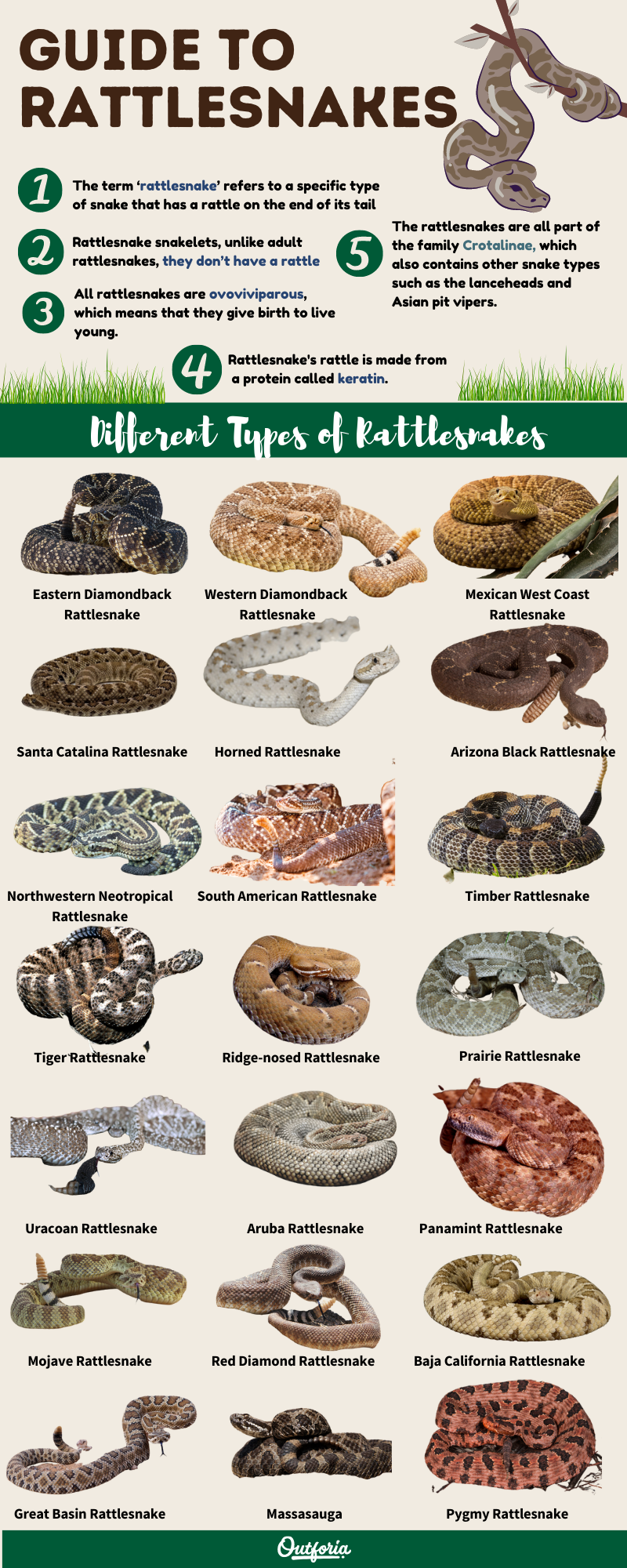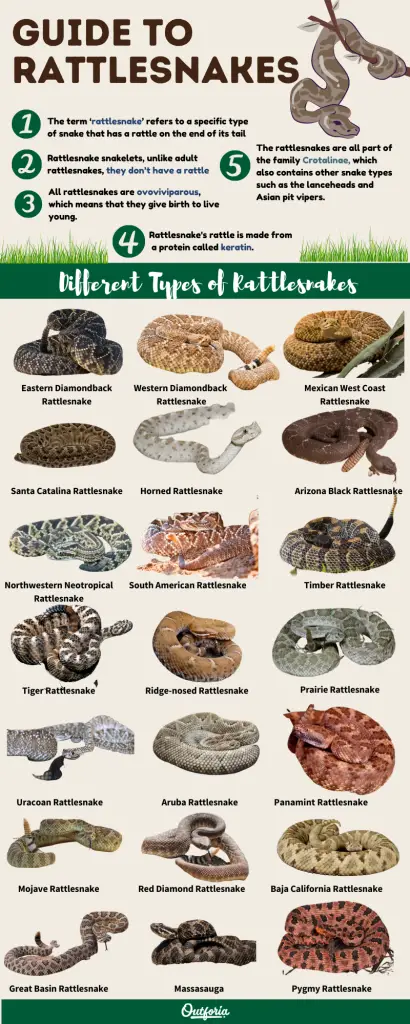Rattlesnakes are some of the most feared and fascinating creatures in the world. These venomous snakes are found in a variety of habitats across North and South America, and they come in many different shapes and sizes. But what are the different types of rattlesnakes, and how can you tell them apart? In this article, we’ll explore the diverse world of rattlesnakes and learn about the unique characteristics that make each species so special. So let’s get started and discover the incredible diversity of these deadly yet beautiful creatures!
There are over 30 species of rattlesnakes found in North and South America. Some of the most common types of rattlesnakes include the Western Diamondback, Eastern Diamondback, Timber Rattlesnake, Sidewinder, and Mojave Rattlesnake. Each species has its own distinct characteristics and range, but all are venomous and can pose a danger to humans if provoked.

What Are the Different Types of Rattlesnakes?
Rattlesnakes are a group of venomous snakes that are found exclusively in the Americas. They are known for their distinctive rattle, which they use to warn potential predators or threats. Rattlesnakes are fascinating creatures, and there are many different types of rattlesnakes that exist. In this article, we will explore the different types of rattlesnakes and their unique characteristics.
Eastern Diamondback Rattlesnake
The Eastern Diamondback Rattlesnake is the largest venomous snake in North America, and it is also one of the most dangerous. They can grow up to 8 feet in length and weigh over 10 pounds. Their distinctive diamond-shaped pattern on their backs is where they get their name. The Eastern Diamondback Rattlesnake is found in the southeastern United States, and they prefer to live in dry, sandy areas.
Eastern Diamondback Rattlesnakes are known for their potent venom, which can cause severe pain, swelling, and even death. However, they are not aggressive and will only attack if they feel threatened. If you encounter an Eastern Diamondback Rattlesnake, it is best to leave it alone and give it plenty of space.
Western Diamondback Rattlesnake
The Western Diamondback Rattlesnake is found in the southwestern United States and Mexico. They are slightly smaller than the Eastern Diamondback Rattlesnake, growing up to 6 feet in length. They have a distinctive diamond-shaped pattern on their backs, similar to the Eastern Diamondback Rattlesnake.
Western Diamondback Rattlesnakes are also venomous, and their venom can cause severe pain, swelling, and even death. They are known for their aggressive behavior and will attack if they feel threatened. It is best to avoid encounters with Western Diamondback Rattlesnakes and to give them plenty of space if you do encounter them.
Mojave Rattlesnake
The Mojave Rattlesnake is found in the southwestern United States and Mexico. They have a distinctive greenish-gray coloration and a diamond-shaped pattern on their backs. They are known for their potent venom, which is a combination of neurotoxins and hemotoxins. Their venom can cause severe pain, paralysis, and even death.
Mojave Rattlesnakes are not as aggressive as some of the other rattlesnake species, but they will defend themselves if they feel threatened. It is best to give them plenty of space and to avoid encounters with them.
Timber Rattlesnake
The Timber Rattlesnake is found in the eastern United States. They are also known as the Canebrake Rattlesnake because they prefer to live in areas with dense underbrush and cane thickets. They have a distinctive pattern on their backs, which can vary from dark brown to gray.
Timber Rattlesnakes are venomous, but their venom is not as potent as some of the other rattlesnake species. They are known for their docile behavior and will often try to escape rather than attack. However, if they feel threatened, they will defend themselves.
Massasauga Rattlesnake
The Massasauga Rattlesnake is found in the central United States and Canada. They are a small rattlesnake, growing only up to 30 inches in length. They have a distinctive pattern on their backs, which can vary from gray to brown.
Massasauga Rattlesnakes are venomous, but their venom is not as potent as some of the other rattlesnake species. They are known for their docile behavior and will often try to escape rather than attack. However, if they feel threatened, they will defend themselves.
Sidewinder Rattlesnake
The Sidewinder Rattlesnake is found in the southwestern United States and Mexico. They have a distinctive horn-shaped projection above each eye, which gives them their name. They are also known for their unique method of locomotion, which involves moving sideways in a series of S-shaped curves.
Sidewinder Rattlesnakes are venomous, but their venom is not as potent as some of the other rattlesnake species. They are known for their docile behavior and will often try to escape rather than attack. However, if they feel threatened, they will defend themselves.
Benefits of Rattlesnakes
Despite their reputation as dangerous creatures, rattlesnakes play an important role in their ecosystem. They help to control rodent populations, which can be a nuisance to farmers and homeowners. Rattlesnakes are also an important part of the food chain, providing food for predators such as hawks, eagles, and coyotes.
Rattlesnakes vs. Humans
While rattlesnakes are an important part of the ecosystem, they can also pose a threat to humans. It is important to be aware of your surroundings when hiking or camping in areas where rattlesnakes are known to live. If you encounter a rattlesnake, it is best to give it plenty of space and to avoid disturbing it.
If you are bitten by a rattlesnake, it is important to seek medical attention immediately. Rattlesnake bites can be life-threatening, and prompt treatment is essential for a good outcome.
In Conclusion
Rattlesnakes are fascinating creatures, and there are many different types of rattlesnakes that exist. While they can pose a threat to humans, they also play an important role in their ecosystem. It is important to be aware of your surroundings and to avoid disturbing rattlesnakes if you encounter them. If you do get bitten by a rattlesnake, seek medical attention immediately to ensure the best possible outcome.
Frequently Asked Questions
What are the physical characteristics of a typical rattlesnake?
Rattlesnakes are venomous snakes that are commonly found in North and South America. They are easily recognizable by their distinctive rattle, which is located at the end of their tail. Most rattlesnakes have a triangular-shaped head, vertical pupils, and a heat-sensing pit located between their nostrils. Their skin is covered in scales, and their coloration can vary depending on the species and their environment.
Rattlesnakes are also known for their large fangs, which they use to inject venom into their prey. Their venom is a potent neurotoxin that can cause severe pain, swelling, and even death in humans and other animals.
What are the different types of rattlesnakes?
There are over 30 species of rattlesnakes, each with their own unique characteristics and habitat preferences. Some of the most common types of rattlesnakes include the Western Diamondback, Eastern Diamondback, Timber Rattlesnake, Mojave Rattlesnake, and Southern Pacific Rattlesnake.
Each species has its own distinct coloration and pattern, as well as variations in size and behavior. For example, the Western Diamondback is known for its distinctive diamond-shaped pattern on its back, while the Mojave Rattlesnake is known for its potent venom.
What is the habitat and distribution of rattlesnakes?
Rattlesnakes are found throughout North and South America, from Canada to Argentina. They are most commonly found in dry, arid regions, such as deserts and grasslands, although some species can also be found in forests and wetlands.
Rattlesnakes are well-adapted to their environment and can survive in a variety of conditions. They are able to regulate their body temperature by basking in the sun or seeking shade, and they can go for long periods of time without food or water.
What is the diet of a rattlesnake?
Rattlesnakes are carnivorous and primarily feed on small mammals, such as mice, rats, and rabbits. They are also known to eat birds, lizards, and other snakes. Rattlesnakes use their heat-sensing pits to locate their prey and their venomous fangs to subdue and kill them.
After a rattlesnake has caught its prey, it will swallow it whole and digest it over the course of several days. Because they are cold-blooded, rattlesnakes do not need to eat as frequently as warm-blooded animals.
How can I avoid a rattlesnake bite?
If you are in an area where rattlesnakes are present, it is important to take precautions to avoid getting bitten. Here are some tips:
– Wear long pants and boots to protect your legs and feet.
– Stay on designated trails and avoid walking through tall grass or underbrush.
– Be aware of your surroundings and listen for the sound of a rattlesnake’s rattle.
– If you encounter a rattlesnake, give it plenty of space and slowly back away.
– If you are bitten by a rattlesnake, seek medical attention immediately.
In conclusion, there are many different types of rattlesnakes found throughout North and South America. Each species has its own unique characteristics and behaviors, but all share the distinctive feature of a rattle at the end of their tail. From the massive Eastern diamondback to the tiny pygmy rattlesnake, these snakes play an important role in their ecosystems and should be respected and appreciated from a safe distance.
It’s important to remember that while rattlesnakes can be dangerous, they are not inherently aggressive and will usually only strike if they feel threatened. If you encounter a rattlesnake in the wild, give it plenty of space and avoid disturbing it. With proper awareness and caution, these fascinating creatures can be enjoyed and admired from afar.
In the end, learning about the different types of rattlesnakes can help us better understand and appreciate the biodiversity of our planet. Whether you’re a wildlife enthusiast or simply curious about these impressive reptiles, taking the time to learn about their unique characteristics and behaviors is a worthwhile endeavor. So go out and explore the world of rattlesnakes – just be sure to stay safe and respectful along the way.


